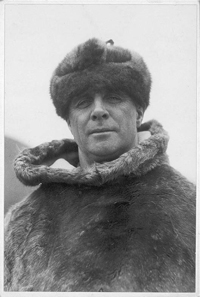Get Today in Masonic History into your Inbox. Sign up today for one of our email lists!
Need an article for your Trestleboard/Newsletter see our Use Policy
Donald Baxter MacMillan is Born

Today in Masonic History Donald Baxter MacMillan is born in 1874.
Donald Baxter MacMillan was an American explorer.
MacMillan was born on November 10th, 1874 in Provincetown, Massachusetts. In 1886 he moved to Freeport, Maine after the passing of his father in 1883, his father was killed while captaining a Grand Banks fishing schooner. Then the passing of his mother suddenly in 1886. He attended Bowdoin College in Brunswick, Maine where he graduated in 1898 with a geology degree. From 1903 to 1908 he taught at the Worcester Academy in Worcester, Massachusetts.
In 1908 MacMillan was recruited by fellow Bowdoin College Alumni, naval officer and explorer, Robert E. Peary. Peary reached out to MacMillan after MacMillan had saved nine shipwrecked people over the course of two nights. MacMillan joined Peary's expedition to the North Pole in 1908. MacMillan only reached 84° 29' when his heels froze and he was forced to turn back. Peary allegedly reached the North Pole 26 days later.
Over the next two years, MacMillan traveled around Labrador, Canada doing ethnological studies among the Innu and Inuit. In 1913, he commanded the ill-fated Crocker Land Expedition to Northern Greenland. Crocker Land was spotted by the Peary Expedition and was believed to be a land mass near Greenland. The land turned out to be a mirage. The expedition became stranded and were not rescued until 1917.
In 1918, MacMillan was made an Ensign in the Naval Reserve Flying Corps. Immediately MacMillan began raising money for another Arctic Expedition. In 1921, a ship was commissioned, the schooner Bowdoin, named after MacMillan's alma mater. After it's launch, MacMillan and his team sailed to Baffin island, which is part of Canada and the fifth largest island in the World. MacMillan and his team spent the winter on Baffin.
In 1923, there were fears of a new Ice Age. MacMillan and his team were sponsored by the National Geographical Society to study advancing glaciers. The same year he was commissioned a lieutenant commander in the Naval Reserve.
In 1926, MacMillan led a group of explorers to Sydney, Nova Scotia. The group included three women and five scientists. The team spent several months collecting flora and fauna specimens in Labrador and Greenland. They also explored the ancient ruins of Sculpin Island which MacMillan believed were the ruins of a 1,000 year old Norse Village. MacMillan found what he believed were the remains of ten to twelve houses. He estimated the houses were hundreds of years old based on the lichen, a composite organism arising from algae and fungi growing together in a symbiotic relationship. MacMillan could not say for certain the structures were created by the Vikings, a local Inuit legend lends some credence to his theory. The local legend states the "stone igloos" were built by men who came from the sea in ships. The Inuit called the site Tunitvik, which means place of the Norseman. The structures also resembled structures found the year before in Greenland.
MacMillan was put on the retired list for the Naval Reserve in 1938. When World War II started, despite being past retirement age, MacMillan was allowed back into the service. He gave the Bowdoin to the Navy and was made it's first military captain. Shortly after, he was transfered to the Hydrographic Office in Washington, DC.
After the war, MacMillan continued his trips to the arctic. He supported a school he helped start called the MacMillan-Moravian School. In 1954, MacMillan was promoted to the rank of rear admiral on the Naval Reserve retired list.
MacMillan passed away on September 7th, 1970. When he passed away at the age of 95, he was the last surviving member of Peary's expedition to the North Pole.
MacMillan was a member of Freeport Lodge No. 23 in Freeport, Maine. He was an honorary member of Kane Lodge No. 454, New York City (the Explorer's Lodge). He was a member of New Jerusalem Chapter No. 3, Royal Arch Masons Wiscassett, Maine, St. Albans Commandery No. 8, Knights Templar in Portland, Maine and a member of Aleppo Shrine Temple, Boston, Massachusetts.

